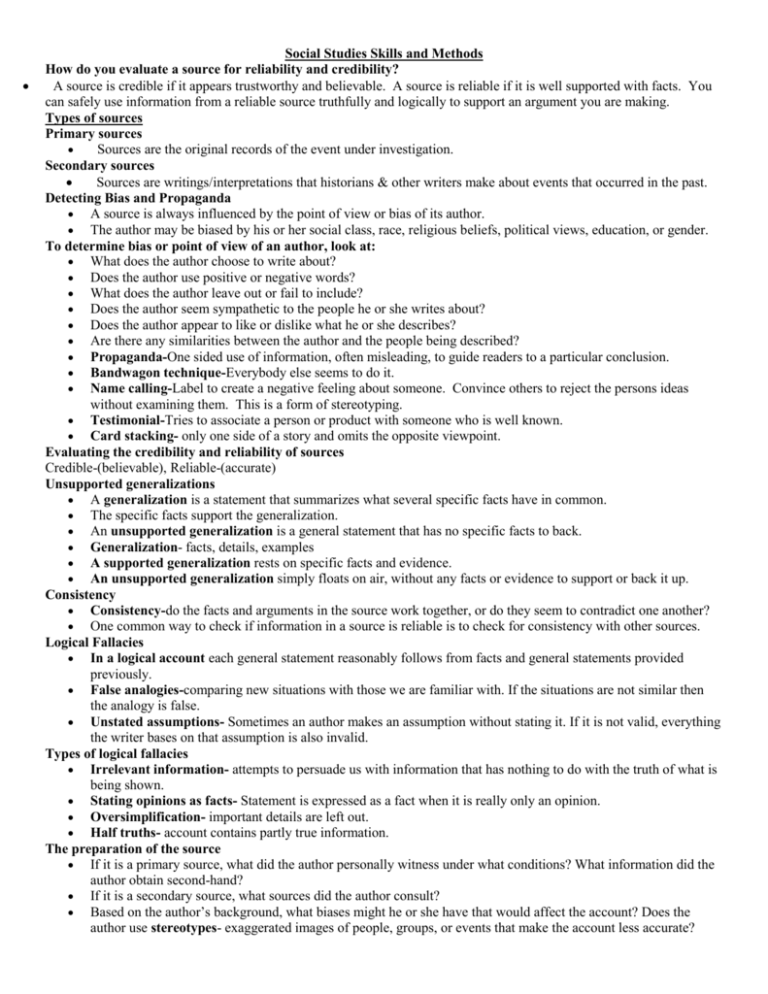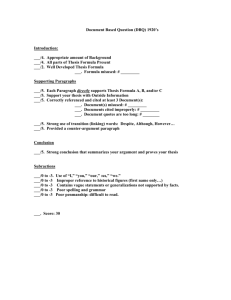Social Studies Skills and Methods
advertisement

Social Studies Skills and Methods How do you evaluate a source for reliability and credibility? A source is credible if it appears trustworthy and believable. A source is reliable if it is well supported with facts. You can safely use information from a reliable source truthfully and logically to support an argument you are making. Types of sources Primary sources Sources are the original records of the event under investigation. Secondary sources Sources are writings/interpretations that historians & other writers make about events that occurred in the past. Detecting Bias and Propaganda A source is always influenced by the point of view or bias of its author. The author may be biased by his or her social class, race, religious beliefs, political views, education, or gender. To determine bias or point of view of an author, look at: What does the author choose to write about? Does the author use positive or negative words? What does the author leave out or fail to include? Does the author seem sympathetic to the people he or she writes about? Does the author appear to like or dislike what he or she describes? Are there any similarities between the author and the people being described? Propaganda-One sided use of information, often misleading, to guide readers to a particular conclusion. Bandwagon technique-Everybody else seems to do it. Name calling-Label to create a negative feeling about someone. Convince others to reject the persons ideas without examining them. This is a form of stereotyping. Testimonial-Tries to associate a person or product with someone who is well known. Card stacking- only one side of a story and omits the opposite viewpoint. Evaluating the credibility and reliability of sources Credible-(believable), Reliable-(accurate) Unsupported generalizations A generalization is a statement that summarizes what several specific facts have in common. The specific facts support the generalization. An unsupported generalization is a general statement that has no specific facts to back. Generalization- facts, details, examples A supported generalization rests on specific facts and evidence. An unsupported generalization simply floats on air, without any facts or evidence to support or back it up. Consistency Consistency-do the facts and arguments in the source work together, or do they seem to contradict one another? One common way to check if information in a source is reliable is to check for consistency with other sources. Logical Fallacies In a logical account each general statement reasonably follows from facts and general statements provided previously. False analogies-comparing new situations with those we are familiar with. If the situations are not similar then the analogy is false. Unstated assumptions- Sometimes an author makes an assumption without stating it. If it is not valid, everything the writer bases on that assumption is also invalid. Types of logical fallacies Irrelevant information- attempts to persuade us with information that has nothing to do with the truth of what is being shown. Stating opinions as facts- Statement is expressed as a fact when it is really only an opinion. Oversimplification- important details are left out. Half truths- account contains partly true information. The preparation of the source If it is a primary source, what did the author personally witness under what conditions? What information did the author obtain second-hand? If it is a secondary source, what sources did the author consult? Based on the author’s background, what biases might he or she have that would affect the account? Does the author use stereotypes- exaggerated images of people, groups, or events that make the account less accurate? What is the date of publication? Was the source written at the time of the event? This might make a primary source more credible. Or was the source written closer to today? Think about the qualifications and reputation of the writer. Characteristics of a credible and reliable source Facts used by the source are accurate. Statements and conclusions are logically supported by facts. The source is recognized as being knowledgeable one. Facts can be verified by the use of other sources. The source is close to the events it reports. How are data and evidence used to support a thesis? To write logically and persuasively: Pay careful attention to the sources you use. Make sure your general statements are logically connected. Always select the best evidence to support your general statements. Avoid unstated assumptions, unsupported generalizations, inconsistent arguments or facts, logical fallacies, and propaganda techniques. How to write a report A report can be either an oral presentation or a written paper that gives specific information about a topic. Choose a topic You need to select a topic that is important enough for you to find information about it and to write something interesting. But not so broad that you cannot describe or explain it fully. Think of your topic as a question you wish to answer. Make a thesis A thesis is the main point you present in a report. Its presented as a single sentence that states what your report will show. Everything in your report should be related in some way to that thesis. You can change and modify your thesis as you conduct your research. Gather and use information You must gather information on your topic. This process is called research because you are searching for information about your topic. Look at reference books, newspapers, magazines, books, and the internet. Write your notes on index cards. Examine your notes. Decide what to keep and what to discard. Consider what conclusions you wish to draw and how they are connected. Use the best facts available to support each of your general statements. These general statements should in return support your thesis. Use logical, well-supported, consistent arguments and to avoid unsupported generalizations, logical fallacies, and propaganda techniques. Thesis: The government should protect wolves from hunters. Fact: In 1995, deer were multiplying too fast in the nation parks. Fact: Wolves hunt deer. Conclusion: Protecting wolves in national parks will help to keep the deer population under control. In this example two facts support a conclusion that in turn supports the author’s thesis. Everything you include must relate in some way to your thesis- the argument you are making.





